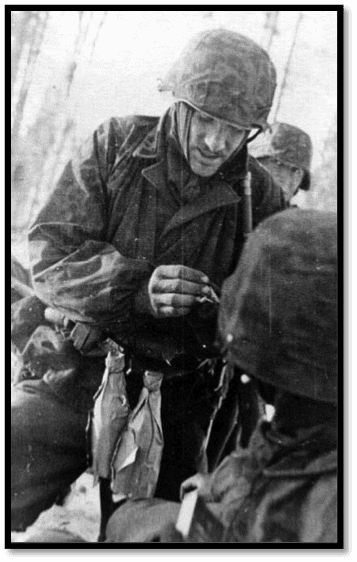Note: Busy readers can skip down to the subhead titled “Winning the business.”
Enabling military commanders (and policy makers) to counter and forestall threats to America’s way of life is what the DoD Defense Technical Information Center (DTIC), Information Analysis Centers (IAC) Multiple Award Contract (MAC) is all about.

A RETURN TO COLD WARFARE? — Current technology is light years ahead of where it was in the 1945 to 1990 period, but the game’s becoming the same as it was during the Cold War
The Pentagon is spending $28B to put America’s vast endowment of brain power to work on the knotty problems of defeating our enemies on today’s battlefields, in the air, on land, on sea and in the cyber realm, including social media’s turf. And DOD’s planning to spread the wealth around here: 29 awardees are expected in this hybrid F&O and SB/S-A Contract.
Bidders should up their government proposal writing capabilities on this one. This is a particularly wide-ranging, high-stakes Research, Development Testing and Evaluation (RDT&D) effort. It comes with some tough requirements – For example, TO bidders may have to respond to inquiries and questions in as little as 4 hours.
The finalized draft of the DTIC IAC MAC RFP is expected to drop next month, October. And there will be plenty of work to do!
ГРЯЗНЫЙ БИЗНЕС! (DIRTY BUSINESS!)
Daily it seems, America’s security guardians in the FBI and DHS and our intelligence operatives in the IC, etc. are uncovering ever more compelling evidence of Russia’s nefarious efforts to destabilize America’s democracy, and those of Germany, France, etc., through disinformation systematically disseminated on various social media: Facebook, Twitter, etc.

PLAYING IT COY – Vladimir Putting’s denied any Russian involvement in weaponizing social media and turning it into a cyberwar battlefield; he has allowed that “free-spirited” hackers might be contributing voluntarily to “the fight against those who say bad things about Russia.”
Apparently, Russia’s turned these and other social media tools – all of which are American — into engines of deception and propaganda. It’s unleashed a red menacing cyberarmy of counterfeit Facebook and Twitter accounts, a veritable legion of Russian- planted and controlled impostor bots. Case in point: DCLeaks.com, which was created in June 2016 by the Russian military intelligence agency G.R.U. DCLeaks began publishing an eclectic collection of hacked emails, notably from George Soros, the financier and Democratic donor, as well as a former NATO commander and some Democratic and Republican staffers.
Some of the website’s language — calling Mrs. Clinton “President of the Democratic Party” and referring to her “electional staff” — seemed to belie its pose as a forum run by American activists.
Be that as it may, DCLeaks just one example, among many, of what our enemies are capable of. And what winners of the DTIC IAC MAC IDIQ must be ready to contend with.
PUSHING BACK
Fortunately, DOD IAC’s provide the perfect vehicle for responding to threats such as those Russia, among others, pose. The IACs collect, analyze and compile data that answer recurring challenges, identify long-term trends and provide recommendations to the DoD research and acquisition communities. And its contractors who provide the high-caliber brain power ammo that enables the IACs to destroy enemy targets, which they have done successfully going back to the Cold War era, when US Russian relations were similarly chilly. he IAC program puts thousands of top-flight scientists and engineers to work in over 270 Technical Area Tasks (TATs), organized into three areas.
They are:

(ANTI)SOCIAL MEDIA TARGET – George Soros, Billionaire Backer of the Democratic Party and the Clinton juggernaut, is purportedly one of the targets of the Kremlin’s social media disinformation campaign.
- Cyber Security and Information Systems Information Analysis Center (CSIAC)
Focus areas: • Cyber Security • Software Data & Analysis • Knowledge Management & Information Sharing • Modeling & Simulation.
Current Awardees: 10 large, 6 small.
- Defense Systems Information Analysis Center (DSIAC)
Focus areas: • Advanced Materials • Autonomous Systems • Directed Energy • Energetics • Military Sensing • Non-lethal Weapons and Information Operations • Reliability, Maintainability, Quality, Supportability, and Interoperability (RMQSI) • Survivability and Vulnerability • Weapons Systems.
Current Awardees: 9 large, 3 small.
- Homeland Defense and Security Information Analysis Center (HDIAC)
Focus areas: Homeland Security and Defense • Critical Infrastructure Protection (CIP) • Weapons of Mass Destruction (WMD) • Chemical, Biological, Radiological, Nuclear (CBRN) Defense • Biometrics • Medical • Cultural Studies • Alternative Energy.
Current awardees: 11 large, 2 small.
WINNING THE BUSINESS
The DTIC is a best value deal using a Combination Subjective Tradeoff/Technically Acceptable-Unacceptable Selection Criteria.
Bidders should note that the proposal requirements for this four-volume submission are especially complex. The General Instructions and Information (Section L) and Basis for Award (Section M) components of the DTIC drat RFP weigh in at 50 pages. Navigating the maze of different award pool requirements is just one of the complicated submission-related tasks. There are three sets of pool-related requirements: one covering full and open, the other set-aside, and the third Chemical Biological Radiological and Nuclear (CBRN) support. Each pool has its own separate set of bid requirements.
Full and Open — Competitors for the full and open pool (Pool 1) will have to respond to two sample TO’s: one covering Reliability, Maintainability, Quality, Supportability, and Interoperability (RMQSI), Weapon Systems and Software Data and Analysis; and the other: Military Sensing, Survivability & Vulnerability, and Cyber Security. (Each is limited to 25 pages). In a third section, offerors must provide a Demonstrated Capability Narrative covering all remaining 16 other F&O technical focus areas — (with a 2-page limit for each, thus a 32-page section limit.) Also required: an 18-page Program Management narrative, including up to three pages of marketing plan material. The small business participation sections of Pools 1, 2, and 3 have no page length limitation.

THINKING OUTSIDE THE BOTTLE – A perennial favorite with Armed Forces and insurgents alike, the Molotov Cocktail (a/k/a Petrol Bomb, Bottle Bomb, Poor Man’s Grenade, etc.) was named after the then Russian Foreign Minister Vyacheslav Molotov. First used by the Finnish Army during the Winter War of 1939-1940, it proved effective in burning Russian Tank crews to a crisp inside their tracked vehicles.
SB/S-A — For the Set Aside Pool (Pool 2), contestants will have to respond to just one Sample TO covering Survivability & Vulnerability, Weapon Systems, and Software Data and Analysis (limited to 15 pages), as well as a demonstrated capability narrative covering 10 other technical focus areas (with a two-page limit for each, total 20 pages) and, additionally, an 18-page Program Management Narrative.
CBRN — The third, CBRN, pool (Pool 3), write up requirement is similar in size and scope to the other two; it’s focused, of course on offerors’ capabilities in the Chemical, Biological Radiological and Nuclear realm.
With regard to Past Performance write ups, 12 are required, with 5 as prime, for Pool 1; 8, with 4 as prime, for Pool 2, and 5, with 3 as prime, for Pool 3. Page limits for the different Pools’ PP sections are 67, 47 and 32, respectively. Bidders must address relevancy and recency requirements super carefully.
Each pool’s evaluation is handled separately, and thus separate proposals are required for each pool; no two awards for the price of one prop allowed.
Serious bidders won’t go it alone, but should seriously consider augmenting their proposal teams.
THINKING OUTSIDE THE BOX
Awardees will be called upon to anticipate and respond very quickly to the most pressing and complex military and security-related problems.

THE SUMMONS – HONORING AMERICA’s COLD WAR COMMITMENT — Now the trumpet summons us again-not as a call to bear arms, though arms we need–not as a call to battle, though embattled we are–but a call to bear the burden of a long twilight struggle, year in and year out, “rejoicing in hope, patient in tribulation”–a struggle against the common enemies of man: tyranny, poverty, disease and war itself.
Contractors who are serious about winning this thing and being awarded multiple TO’s must show clearly, they know how to deal with an Agile DevOps environment currently favored throughout the USG/DOD. The eleven-figure price tag and the fact that they’ll be just shy of 30 awardees justifies bringing out all the BD and Capture heavy artillery, and augmenting proposal preparation staff.





How does someone find out who the potential bidders/awarded are?
Hi Ron!
If someone is trying to identify teaming partners,
they could look up companies in the same NAICS
code in the SAMS contractor registry or on GovWin,
Govtribe.com, or Manta.com.